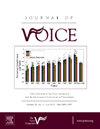Characteristics of Laryngopharyngeal Reflux in Patients of Different Genders and Ages
IF 2.5
4区 医学
Q1 AUDIOLOGY & SPEECH-LANGUAGE PATHOLOGY
引用次数: 0
Abstract
Objectives
To investigate the differences in laryngopharyngeal reflux (LPR) characteristics between gender and age groups based on the Reflux Symptom Index (RSI), Reflux Finding Score (RFS) scale and 24-hour hypopharyngeal-esophageal multichannel intraluminal impedance-pH (HEMII-pH) monitoring.
Methods
The enrolled were patients with LPR symptoms completed the 24h-HEMII-pH monitoring and divided into two gender groups (male and female) and elderly group (>60 years), middle-aged group (41-60 years) and young group (18-40 years). The total RSI and RFS scores of individuals were counted. Various potential differences as well as incidence of each type of LPR events between gender and age groups were analyzed.
Results
A total of 420 patients were included, with 333 (79.3%) diagnosed with LPR confirmed by 24h-HEMII-pH monitoring. Females (n=49) had a statistically higher LPR positivity (91.0% vs. 76.6%, P < 0.01) than males (n=342). Female patients with LPR had significantly higher RSI scores (14.08 ± 6.72 vs. 11.08 ± 4.82, P < 0.001) than male patients. The positive rate of LPR were 82.6%, 80.7% and 63.3% in the elderly, middle-aged and young groups. The Elderly group had significantly lower RSI scores (10.20 ± 4.06 vs. 12.80 ± 6.58, 12.24 ± 5.57, P < 0.001) but higher RFS scores (9.37 ± 3.25 vs. 8.16 ± 3.34, 8.57 ± 2.58, P < 0.05) than the other two groups. The number of acid hypopharyngeal-proximal reflux episodes (HREs) and distal esophageal acid reflux were significantly higher in elderly than in young patients. Except for non-acid gas HREs, the positive rates of other types of HREs were increasing from young to middle-aged to the elderly group (P < 0.05).
Conclusions
Female patients with suspected LPR symptoms had a higher positive rate of LPR and RSI score than males. The prevalence of LPR and the number of acid reflux were progressively increasing with age, but the perception of reflux symptoms may diminish.
不同性别和年龄患者的喉咽反流特征
目的根据反流症状指数(RSI)、反流发现评分(RFS)量表和24小时咽下-食管多通道腔内阻抗-pH(HEMII-pH)监测,研究不同性别和年龄组之间喉咽反流(LPR)特征的差异:入组的 LPR 患者均完成了 24 小时下咽-食道多通道腔内阻抗-pH 监测,并分为两个性别组(男性和女性)以及老年组(60 岁以上)、中年组(41-60 岁)和青年组(18-40 岁)。统计每个人的 RSI 和 RFS 总分。分析了不同性别和年龄组之间的各种潜在差异以及各类 LPR 事件的发生率:结果:共纳入 420 名患者,其中 333 人(79.3%)通过 24h-HEMII-pH 监测确诊为 LPR。据统计,女性(49 人)的 LPR 阳性率(91.0% vs. 76.6%,P < 0.01)高于男性(342 人)。女性 LPR 患者的 RSI 评分(14.08 ± 6.72 vs. 11.08 ± 4.82,P < 0.001)明显高于男性患者。老年组、中年组和青年组的 LPR 阳性率分别为 82.6%、80.7% 和 63.3%。老年组的 RSI 评分(10.20 ± 4.06 vs. 12.80 ± 6.58, 12.24 ± 5.57, P < 0.001)明显低于其他两组,但 RFS 评分(9.37 ± 3.25 vs. 8.16 ± 3.34, 8.57 ± 2.58, P < 0.05)高于其他两组。老年患者的酸性咽下-近端反流发作(HRE)次数和食管远端酸性反流次数明显高于年轻患者。除非酸性气体反流外,其他类型反流的阳性率从年轻组到中年组再到老年组均呈上升趋势(P < 0.05):女性疑似 LPR 患者的 LPR 阳性率和 RSI 评分均高于男性。随着年龄的增长,LPR 的患病率和反酸次数逐渐增加,但对反流症状的感知可能会减弱。
本文章由计算机程序翻译,如有差异,请以英文原文为准。
求助全文
约1分钟内获得全文
求助全文
来源期刊

Journal of Voice
医学-耳鼻喉科学
CiteScore
4.00
自引率
13.60%
发文量
395
审稿时长
59 days
期刊介绍:
The Journal of Voice is widely regarded as the world''s premiere journal for voice medicine and research. This peer-reviewed publication is listed in Index Medicus and is indexed by the Institute for Scientific Information. The journal contains articles written by experts throughout the world on all topics in voice sciences, voice medicine and surgery, and speech-language pathologists'' management of voice-related problems. The journal includes clinical articles, clinical research, and laboratory research. Members of the Foundation receive the journal as a benefit of membership.
 求助内容:
求助内容: 应助结果提醒方式:
应助结果提醒方式:


